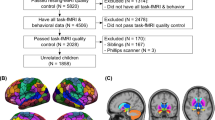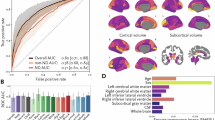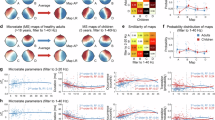Abstract
The distinction between externalizing and internalizing traits has been a classic area of study in psychiatry. However, whether shared or unique brain network features predict internalizing and externalizing behaviors remains poorly understood. Using a sample of 5,260 children from the Adolescent Brain Cognitive Development study, 229 adolescents from the Healthy Brain Network and 423 adults from the Human Connectome Project, we show that predictive network features are, at least in part, distinct across internalizing and externalizing behaviors. Across all three samples, behaviors within internalizing and externalizing categories exhibited more similar predictive feature weights than behaviors between categories. These data suggest shared and unique brain network features account for individual variation within broad internalizing and externalizing categories across developmental stages.
This is a preview of subscription content, access via your institution
Access options
Subscribe to this journal
Receive 12 digital issues and online access to articles
$79.00 per year
only $6.58 per issue
Buy this article
- Purchase on SpringerLink
- Instant access to full article PDF
Prices may be subject to local taxes which are calculated during checkout




Similar content being viewed by others
Data availability
The ABCD data are publicly available via the NIMH Data Archive (NDA) and via https://abcdstudy.org. The HBN data are publicly available via Child Mind Institute Healthy Brain Network at http://fcon_1000.projects.nitrc.org/indi/cmi_healthy_brain_network/Data.html. The HCP data are also publicly available and can be accessed via https://www.humanconnectome.org. Access to all three datasets requires Data Use Agreement.
Code availability
Code for this study is publicly available via Github under the main branch: https://github.com/quyueyue/InternalizingExternalizingPredictions.git. The software dependencies were Freesurfer (5.3.0; https://surfer.nmr.mgh.harvard.edu), FSL (5.0.8; https://fsl.fmrib.ox.ac.uk/fsl/fslwiki/FslInstallation), MATLAB (2018b; https://www.mathworks.com/products/matlab.html), Jupyter Notebook 6.4.5 (Python 3.9.7 ipykernel; https://jupyter.org), Python/3.10.8-GCCcore-12.2.0 (https://www.python.org) and the neuroCombat (v.1.0.13) package in R v.4.2.0.
References
Achenbach, T. M. The child behavior profile: I. Boys aged 6–11. J. Consult. Clin. Psychol. 46, 478–488 (1978).
Achenbach, T. M. Manual for the Child Behavior Checklist/ 4–18 and 1991 Profile (Univ. Vermont, Department of Psychiatry, 1991).
Duprey, E. B., Oshri, A. & Liu, S. Developmental pathways from child maltreatment to adolescent suicide-related behaviors: the internalizing and externalizing comorbidity hypothesis. Dev. Psychopathol. 32, 945–959 (2020).
Commisso, M. et al. Childhood externalizing, internalizing and comorbid problems: distinguishing young adults who think about suicide from those who attempt suicide. Psychol. Med. https://doi.org/10.1017/S0033291721002464 (2021).
Papachristou, E. & Flouri, E. The codevelopment of internalizing symptoms, externalizing symptoms, and cognitive ability across childhood and adolescence. Dev. Psychopathol. 32, 1375–1389 (2020).
Narusyte, J., Ropponen, A., Alexanderson, K. & Svedberg, P. Internalizing and externalizing problems in childhood and adolescence as predictors of work incapacity in young adulthood. Soc. Psychiatry Psychiatr. Epidemiol. 52, 1159 (2017).
Sripada, C. et al. Prediction of neurocognition in youth from resting state fMRI. Mol. Psychiatry 25, 3413–3421 (2019).
Shannon, B. J. et al. Premotor functional connectivity predicts impulsivity in juvenile offenders. Proc. Natl Acad. Sci. USA 108, 11241–11245 (2011).
Uddin, L. Q. et al. Salience network–based classification and prediction of symptom severity in children with autism. JAMA Psychiatry 70, 869 (2013).
Lake, E. M. R. et al. The functional brain organization of an individual allows prediction of measures of social abilities transdiagnostically in autism and attention-deficit/hyperactivity disorder. Biol. Psychiatry 86, 315–326 (2019).
Chen, J. et al. Shared and unique brain network features predict cognitive, personality, and mental health scores in the ABCD study. Nat. Commun. 13, 2217 (2022).
Ooi, L. Q. R. et al. Comparison of individualized behavioral predictions across anatomical, diffusion and functional connectivity MRI. Neuroimage 263, 119636 (2022).
Sydnor, V. J. et al. Neurodevelopment of the association cortices: patterns, mechanisms, and implications for psychopathology. Neuron 109, 2820–2846 (2021).
Hwang, K., Hallquist, M. N. & Luna, B. The development of hub architecture in the human functional brain network. Cereb. Cortex 23, 2380–2393 (2013).
Dong, H. M., Margulies, D. S., Zuo, X. N. & Holmes, A. J. Shifting gradients of macroscale cortical organization mark the transition from childhood to adolescence. Proc. Natl Acad. Sci. USA 118, e2024448118 (2021).
Volkow, N. D. et al. The conception of the ABCD study: from substance use to a broad NIH collaboration. Dev. Cogn. Neurosci. 32, 4–7 (2018).
Alexander, L. M. et al. An open resource for transdiagnostic research in pediatric mental health and learning disorders. Sci. Data 4, 170181 (2017).
Van Essen, D. C. et al. The WU-minn human connectome project: An overview. Neuroimage 80, 62 (2013).
Mackinnon, J. G. in Handbook of Computational Econometrics (eds Belsley, D. A. & Kontoghiorghes, E. J.) 183–213 (WIley, 2009); https://doi.org/10.1002/9780470748916.CH6
Achenbach, T. M. & Rescorla, L. A. Manual for ASEBA School-Age Forms & Profiles (ASEBA, 2001).
Achenbach, T. M. & Rescorla, L. A. Manual for the ASEBA Adult Forms & Profiles (ASEBA, 2003).
Schaefer, A. et al. Local-global parcellation of the human cerebral cortex from intrinsic functional connectivity MRI. Cereb. Cortex 28, 3095–3114 (2018).
Fischl, B. et al. Whole brain segmentation: automated labeling of neuroanatomical structures in the human brain. Neuron 33, 341–355 (2002).
Marek, S. et al. Reproducible brain-wide association studies require thousands of individuals. Nature 603, 654–660 (2022).
Haufe, S. et al. On the interpretation of weight vectors of linear models in multivariate neuroimaging. Neuroimage 87, 96–110 (2014).
Dhamala, E., Jamison, K. W., Jaywant, A. & Kuceyeski, A. Shared functional connections within and between cortical networks predict cognitive abilities in adult males and females. Hum. Brain Mapp. 43, 1087–1102 (2022).
Parkes, L. et al. Transdiagnostic dimensions of psychopathology explain individuals’ unique deviations from normative neurodevelopment in brain structure. Transl. Psychiatry 11, 232 (2021).
Brislin, S. J. et al. Differentiated nomological networks of internalizing, externalizing, and the general factor of psychopathology (‘p factor’) in emerging adolescence in the ABCD study. Psychol. Med. 52, 3051–3061 (2022).
Caspi, A. et al. The p factor: one general psychopathology factor in the structure of psychiatric disorders? Clin. Psychol. Sci. 2, 119 (2014).
Yeo, B. T. T. et al. The organization of the human cerebral cortex estimated by intrinsic functional connectivity. J. Neurophysiol. 106, 1125–1165 (2011).
Krueger, R. F., Markon, K. E., Patrick, C. J., Benning, S. D. & Kramer, M. D. Linking antisocial behavior, substance use, and personality: an integrative quantitative model of the adult externalizing spectrum. J. Abnorm. Psychol. 116, 645–666 (2007).
Eaton, N. R. et al. An invariant dimensional liability model of gender differences in mental disorder prevalence: evidence from a national sample. J. Abnorm. Psychol. 121, 282–288 (2012).
Achenbach, T. M. & Edelbrock, C. S. Psychopathology of childhood. Annu. Rev. Psychol. 35, 227–256 (2003).
Kessler, R. C. et al. Development of lifetime comorbidity in the world health organization world mental health surveys. Arch. Gen. Psychiatry 68, 90–100 (2011).
Ringwald, W. R., Forbes, M. K. & Wright, A. G. C. Meta-analytic tests of measurement invariance of internalizing and externalizing psychopathology across common methodological characteristics. J. Psychopathol. Clin. Sci. 131, 847–856 (2022).
Rosenberg, M. D., Finn, E. S., Scheinost, D., Constable, R. T. & Chun, M. M. Characterizing attention with predictive network models. Trends Cogn. Sci. 21, 290–302 (2017).
Rosenberg, M. D. et al. A neuromarker of sustained attention from whole-brain functional connectivity. Nat. Neurosci. 19, 165–171 (2015).
Satterthwaite, T. D. et al. Connectome-wide network analysis of youth with psychosis-spectrum symptoms. Mol. Psychiatry 20, 1508–1515 (2015).
Pornpattananangkul, N., Leibenluft, E., Pine, D. S. & Stringaris, A. Association between childhood anhedonia and alterations in large-scale resting-state networks and task-evoked activation. JAMA Psychiatry 76, 624–633 (2019).
Karcher, N. R., O’Brien, K. J., Kandala, S. & Barch, D. M. Resting-state functional connectivity and psychotic-like experiences in childhood: results from the adolescent brain cognitive development study. Biol. Psychiatry 86, 7–15 (2019).
He, T. et al. Deep neural networks and kernel regression achieve comparable accuracies for functional connectivity prediction of behavior and demographics. Neuroimage 206, 116276 (2020).
Narumoto, J., Okada, T., Sadato, N., Fukui, K. & Yonekura, Y. Attention to emotion modulates fMRI activity in human right superior temporal sulcus. Cogn. Brain Res. 12, 225–231 (2001).
Mellem, M. S., Jasmin, K. M., Peng, C. & Martin, A. Sentence processing in anterior superior temporal cortex shows a social-emotional bias. Neuropsychologia 89, 217–224 (2016).
Völlm, B. A. et al. Neuronal correlates of theory of mind and empathy: a functional magnetic resonance imaging study in a nonverbal task. Neuroimage 29, 90–98 (2006).
Bigler, E. D. et al. Superior temporal gyrus, language function, and autism. Dev. Neuropsychol. 31, 217–238 (2007).
Weinrich, M., Wise, S. P. & Mauritz, K. H. A neurophysiological study of the premotor cortex in the rhesus monkey. Brain 107, 385–414 (1984).
Cunnington, R., Windischberger, C., Deecke, L. & Moser, E. The preparation and readiness for voluntary movement: a high-field event-related fMRI study of the Bereitschafts-BOLD response. Neuroimage 20, 404–412 (2003).
Kwan, H. C., MacKay, W. A., Murphy, J. T. & Wong, Y. C. Spatial organization of precentral cortex in awake primates. II. Motor outputs. J. Neurophysiol. 41, 1120–1131 (1978).
Penfield, W. & Boldrey, E. Somatic motor and sensory representation in the cerebral cortex of man as studied by electrical stimulation. Brain 60, 389–443 (1937).
Lees, B. et al. Altered neurocognitive functional connectivity and activation patterns underlie psychopathology in preadolescence. Biol. Psychiatry Cogn. Neurosci. Neuroimaging 6, 387–398 (2021).
Grayson, D. S. & Fair, D. A. Development of large-scale functional networks from birth to adulthood: a guide to neuroimaging literature. Neuroimage 160, 15 (2017).
Galván, A. & Tottenham, N. in Developmental Psychopathology 3rd edn (ed. Cicchetti, D.) Ch. 18 (Wiley, 2016); https://doi.org/10.1002/9781119125556.DEVPSY218
Casey, B. J., Galván, A. & Somerville, L. H. Beyond simple models of adolescence to an integrated circuit-based account: a commentary. Dev. Cogn. Neurosci. 17, 128 (2016).
van Dijk, K. R. A., Sabuncu, M. R. & Buckner, R. L. The influence of head motion on intrinsic functional connectivity MRI. Neuroimage 59, 431 (2012).
Power, J. D., Barnes, K. A., Snyder, A. Z., Schlaggar, B. L. & Petersen, S. E. Spurious but systematic correlations in functional connectivity MRI networks arise from subject motion. Neuroimage 59, 2142–2154 (2012).
Li, J. et al. Cross-ethnicity/race generalization failure of behavioral prediction from resting-state functional connectivity. Sci. Adv. 8, 1812 (2022).
Dhamala, E., Yeo, B. T. T. & Holmes, A. J. One size does not fit all: methodological considerations for brain-based predictive modeling in psychiatry. Biol. Psychiatry 93, 717–728 (2023).
Dhamala, E. et al. Brain-based predictions of psychiatric illness-linked behaviors across the sexes. Biol. Psychiatry https://doi.org/10.1016/J.BIOPSYCH.2023.03.025 (2023).
Auchter, A. M. et al. A description of the ABCD organizational structure and communication framework. Dev. Cogn. Neurosci. 32, 8–15 (2018).
Clark, D. B. et al. Biomedical ethics and clinical oversight in multisite observational neuroimaging studies with children and adolescents: the ABCD experience. Dev. Cogn. Neurosci. 32, 143–154 (2018).
Li, J. et al. Global signal regression strengthens association between resting-state functional connectivity and behavior. Neuroimage 196, 126–141 (2019).
Casey, B. J. et al. The Adolescent Brain Cognitive Development (ABCD) study: imaging acquisition across 21 sites. Dev. Cogn. Neurosci. 32, 43 (2018).
Hagler, D. J. et al. Image processing and analysis methods for the Adolescent Brain Cognitive Development Study. Neuroimage 202, 116091 (2019).
Fischl, B., Liu, A. & Dale, A. M. Automated manifold surgery: constructing geometrically accurate and topologically correct models of the human cerebral cortex. IEEE Trans. Med. Imaging 20, 70–80 (2001).
Dale, A. M., Fischl, B. & Sereno, M. I. Cortical surface-based analysis. I. Segmentation and surface reconstruction. Neuroimage 9, 179–194 (1999).
Fischl, B., Sereno, M. I., Tootell, R. B. H. & Dale, A. M. High-resolution intersubject averaging and a coordinate system for the cortical surface. Hum. Brain Mapp. 8, 272 (1999).
Fischl, B., Sereno, M. I. & Dale, A. M. Cortical surface-based analysis. II: inflation, flattening, and a surface-based coordinate system. Neuroimage 9, 195–207 (1999).
Ségonne, F. et al. A hybrid approach to the skull stripping problem in MRI. Neuroimage 22, 1060–1075 (2004).
Ségonne, F., Pacheco, J. & Fischl, B. Geometrically accurate topology-correction of cortical surfaces using nonseparating loops. IEEE Trans. Med. Imaging 26, 518–529 (2007).
Greve, D. N. & Fischl, B. Accurate and robust brain image alignment using boundary-based registration. Neuroimage 48, 63 (2009).
FsFast - Free Surfer wiki. https://surfer.nmr.mgh.harvard.edu/fswiki/FsFast (2011).
Jenkinson, M., Bannister, P., Brady, M. & Smith, S. Improved optimization for the robust and accurate linear registration and motion correction of brain images. Neuroimage 17, 825–841 (2002).
Gratton, C. et al. Removal of high frequency contamination from motion estimates in single-band fMRI saves data without biasing functional connectivity. Neuroimage 217, 116866 (2020).
Gordon, E. M. et al. Generation and evaluation of a cortical area parcellation from resting-state correlations. Cereb. Cortex 26, 288–303 (2016).
Kong, R. et al. Spatial topography of individual-specific cortical networks predicts human cognition, personality, and emotion. Cereb. Cortex 29, 2533–2551 (2019).
Power, J. D. et al. Methods to detect, characterize, and remove motion artifact in resting state fMRI. Neuroimage 84, 320–341 (2014).
Yu, M. et al. Statistical harmonization corrects site effects in functional connectivity measurements from multi-site fMRI data. Hum. Brain Mapp. 39, 4213 (2018).
Glasser, M. F. et al. The minimal preprocessing pipelines for the Human Connectome Project. Neuroimage 80, 105–124 (2013).
Van Essen, D. C., Glasser, M. F., Dierker, D. L., Harwell, J. & Coalson, T. Parcellations and hemispheric asymmetries of human cerebral cortex analyzed on surface-based atlases. Cereb. Cortex 22, 2241–2262 (2012).
Jenkinson, M. & Smith, S. A global optimisation method for robust affine registration of brain images. Med. Image Anal. 5, 143–156 (2001).
Smith, S. M. et al. Advances in functional and structural MR image analysis and implementation as FSL. Neuroimage 23, S208–S219 (2004).
Barch, D. M. et al. Demographic, physical and mental health assessments in the adolescent brain and cognitive development study: rationale and description. Dev. Cogn. Neurosci. 32, 55–66 (2018).
Finn, E. S. et al. Functional connectome fingerprinting: identifying individuals using patterns of brain connectivity. Nat. Neurosci. 18, 1664–1671 (2015).
Kong, R. Schaefer2018 parcellation 400-region 17-network in fslr space. Figshare https://doi.org/10.6084/m9.figshare.10062482.v1 (2019).
Orban, C. Subcortical_regions.png. Figshare https://doi.org/10.6084/m9.figshare.10063016.v1 (2019).
Acknowledgments
Data used in the preparation of this article were obtained, in part, from the Adolescent Brain Cognitive Development (ABCD) Study (https://abcdstudy.org), held in the NIMH Data Archive (NDA). This is a multisite, longitudinal study designed to recruit more than 10,000 children aged 9–10 and follow them over 10 years into early HCP adults. The ABCD study is supported by the National Institutes of Health and additional federal partners under award numbers U01DA041048, U01DA050989, U01DA051016, U01DA041022, U01DA051018, U01DA051037, U01DA050987, U01DA041174, U01DA041106, U01DA041117, U01DA041028, U01DA041134, U01DA050988, U01DA051039, U01DA041156, U01DA041025, U01DA041120, U01DA051038, U01DA041148, U01DA041093, U01DA041089, U24DA041123 and U24DA041147. A full list of supporters is available at abcdstudy.org/federal-partners.html. A list of participating sites and a complete list of the study investigators can be found at abcdstudy.org/consortium_members/. ABCD consortium investigators designed and implemented the study and/or provided data but did not necessarily participate in the analysis or writing of this report. Additional data were provided, in part, by the Human Connectome Project, WU-Minn Consortium (Principal Investigators: D. Van Essen and K. Ugurbil; 1U54MH091657) funded by the 16 NIH institutes and centers that support the NIH Blueprint for Neuroscience Research and by the McDonnell Center for Systems Neuroscience at Washington University. This manuscript reflects the views of the authors and may not reflect the opinions or views of the NIH or the ABCD and HCP consortia investigators. This work was supported by the National Institute of Mental Health (R01MH120080 and R01MH123245 to A.J.H.). This work was also supported by the following awards to B.T.T.Y.: NUS Yong Loo Lin School of Medicine (NUHSRO/2020/124/TMR/LOA), the Singapore National Medical Research Council (NMRC) LCG (OFLCG19May-0035), NMRC CTG-IIT (CTGIIT23jan-0001), NMRC STaR (STaR20nov-0003), Singapore Ministry of Health (MOH) Centre Grant (CG21APR1009) and the Temasek Foundation (TF2223-IMH-01). This work was also supported by the following awards to E.D.: the Kavli Institute for Neuroscience at Yale University (Postdoctoral Fellowship for Academic Diversity), the Feinstein Institutes for Medical Research Advancing Women in Science and Medicine (Career Development Award and Barbara Zucker Emerging Scientist Award). Any opinions, findings and conclusions or recommendations expressed in this material are those of the authors and do not reflect the views of the funders. An earlier version of this paper is available at BioRxiv (https://doi.org/10.1101/2023.05.20.541490v1).
Author information
Authors and Affiliations
Contributions
Y.L.Q. and A.J.H. designed the research, analyzed and interpreted the results, made figures and wrote the paper. Y.L.Q. conducted the research, analyzed the data and reviewed and published the code. Y.L.Q., J.C., A.T., L.Q.R.O., E.D., C.V.C., S.Z., T.Z., C.L., B.T.T.Y. and A.J.H. provided analytic support. Y.L.Q., J.C., A.T., L.Q.R.O., E.D., C.V.C., S.Z., T.Z., C.L., B.T.T.Y. and A.J.H. edited the paper.
Corresponding authors
Ethics declarations
Competing interests
The authors declare no conflicts of interest.
Peer review
Peer review information
Nature Mental Health thanks Kelley Gunther, Adrienne Romer and the other, anonymous, reviewer(s) for their contribution to the peer review of this work.
Additional information
Publisher’s note Springer Nature remains neutral with regard to jurisdictional claims in published maps and institutional affiliations.
Supplementary information
Supplementary Information
Supplementary Figs. 1–3, Tables 1–16 and Methods.
Rights and permissions
Springer Nature or its licensor (e.g. a society or other partner) holds exclusive rights to this article under a publishing agreement with the author(s) or other rightsholder(s); author self-archiving of the accepted manuscript version of this article is solely governed by the terms of such publishing agreement and applicable law.
About this article
Cite this article
Qu, Y.L., Chen, J., Tam, A. et al. Distinct brain network features predict internalizing and externalizing traits in children, adolescents and adults. Nat. Mental Health 3, 306–317 (2025). https://doi.org/10.1038/s44220-025-00388-5
Received:
Accepted:
Published:
Issue date:
DOI: https://doi.org/10.1038/s44220-025-00388-5



